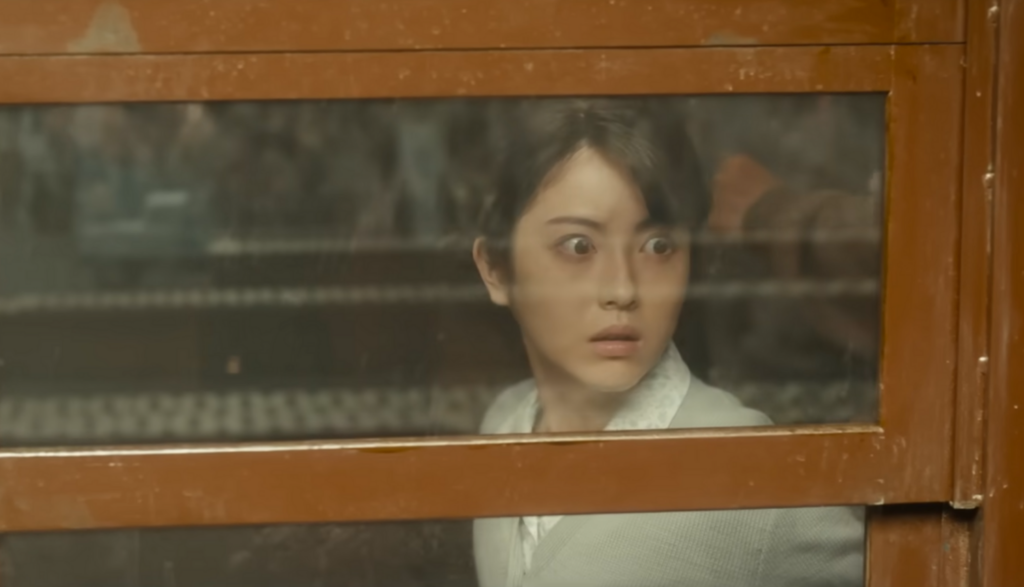
[Editor’s Note: After the success of Godzilla Minus One in its theatrical run late last year, a new version of the film in black and white is being released in theaters Jan. 25 called Godzilla Minus One/Minus Color.]
Koichi Shikishima didn’t die when he was supposed to.
It’s 1945, and the Japanese kamikaze pilot has just launched into what’s supposed to be his sacrificial mission. But instead, Koichi takes a detour, landing at a Japanese mechanical outpost, Odo Island. He claims his plane was having some issues—issues that no one on Odo Island can seem to identify.
The truth is, Koichi is a coward.
One mechanic doesn’t blame him for backing out. They’ve been fighting a losing battle against the United States for a couple of years now.
“Why obey an order to ‘die honorably’ when the outcome is already clear?” The man says.
But Koichi has no time to grapple with his actions: Alarms blare. The outpost is under attack. And when they shine a light on their attacker, they find a massive reptilian creature dubbed Godzilla whose claws tear through the base like a hot knife through butter. The others task Koichi with running to his plane and shooting the beast, but he freezes in terror. And by sunrise, he’s one of a mere two survivors.
A couple of years later, Koichi’s still plagued with guilt over the deaths of the men at Odo Island. It certainly doesn’t help that others constantly remind him of his failure. After all, kamikaze pilots aren’t exactly supposed to come back home. The disgraced man takes a job on a small minesweeper crew, sailing the Pacific Ocean to find and detonate leftover bombs.
It’s not long before Koichi and his crew come face to face with Godzilla. And thanks to United States atomic bomb testing at Bikini Atoll, the beast is even bigger and stronger than Koichi remembers, having been mutated by the radiation. What’s more, the seemingly invincible monster is on a crash course to collide with the Japanese mainland, and the war-weary nation is nowhere near prepared to defend itself.
But for a coward, Koichi sure seems to gravitate to jobs with high mortality rates. And fighting a nuclear reptilian beast with no discernable weakness certainly fits the bill.
Perhaps it’ll even let Koichi finally die with honor—even if the outcome is already clear.
Koichi allows Noriko, a woman who lost her home in the Tokyo bombings, to stay in his home. She brings a baby named Akiko with her, an orphaned child who likewise lost her mother in the bombings. Though Koichi only plans for the two to stay a night, he eventually relents, and the two stay with him for years. Eventually, Akiko grows to see Koichi as her father, and it becomes evident that despite Koichi’s attempt to keep his emotional distance from Noriko and Akiko, he can’t help but love them.
Following the events of Odo Island, Koichi spends several years struggling with survivor’s guilt and PTSD. He blames himself for the deaths of the men stationed there, and he’s further riddled with guilt because, as a kamikaze pilot, he was not supposed to live. Koichi believes it’s disgraceful that he’s still alive, but his fear of death keeps him going.
But Koichi’s mentality changes when he admits his guilt to Noriko, and she begins to help him through it. The next day, Koichi finds a reason to live in Noriko and Akiko. He resolves to “try to live again.”
Another man further emphasizes the point that life is valuable. He laments that in the past, Japan “has treated life far too cheaply,” referencing kamikaze pilots and the desire to die honorably. Instead, the man says, the Japanese people should value life. They should not work in pursuit of an honorable death but for a future worth living in.
And to that end, we should note that many men, even after seeing the absolute devastation wrought by Godzilla, are willing to put their lives on the line to stop the creature.
When we first meet Koichi’s neighbor, Sumiko, she’s yelling to Koichi for coming back from war, telling him that the Tokyo bombings and the subsequent deaths there are his fault because he did not fulfill his duty as a kamikaze pilot. However, Sumiko still chooses to help Koichi take care of Akiko, providing him with resources and watching the child while he and Noriko are away. Eventually, the two have a friendly relationship again.
We hear general comments about fate. Koichi, due to his ongoing struggle with PTSD, occasionally believes his life to be a dream, thinking that he died on Odo Island and is imagining the whole thing. He also believes that the men who did die on Odo Island are haunting him. A woman mockingly asks Koichi if he believes he’s a saint simply for allowing a woman and child to stay in his home for the night.
A man teases another man, telling him he shouldn’t covet a woman with whom he’s interacted. Koichi initially accuses Noriko of being a prostitute.
As you might expect from any Godzilla film, a lot of people die before the credits roll. We see many people get flattened as Godzilla steps on them. Godzilla grabs some people with his mouth and throws them through the sky. Others die as a result of collapsing rubble or explosions caused by the beast as it drags its hands through buildings with the same amount of difficulty as a child destroying a sandcastle. Godzilla likewise tosses and tears through ships, and it’s safe to assume that everyone on board dies each time.
But the biggest moment of carnage comes when Godzilla uses his atomic breath, which, as that description implies, causes an atomic bomb-like explosion at its impact zone. This attack completely decimates a city full of people. Buildings vanish in the blast, and the city is covered in radiation. We’re told that at least 30,000 people died as a result.
Generally, we don’t see the resulting corpses of said dead people because the camera avoids showing most of the explicit carnage. However, we do see the bruised and somewhat bloodied bodies of Koichi’s fellow soldiers after the attack on Odo Island. The most blood we see is when Koichi sustains an injury to his head, causing blood to drip down his face.
When Godzilla is injured by a couple blasts, the creature has some pretty gruesome injuries, such as a hole through its cheek. However, Godzilla’s regenerative abilities cause the injuries to fade away quickly into little more than scar tissue.
We hear about wartime casualties due to the historical bombing of Tokyo. Specifically, we learn that Koichi’s parents died. Likewise, Sumito tells Koichi that her children were killed in the bombings, too.
A man gets knocked out when he’s hit with a pipe. He’s also punched in the face.
“H—” and “d–n” are both used three times each. Someone yells that they’re “screwed.”
A few people drink and smoke cigarettes. Someone is accused of being intoxicated.
None.
Can you fill his skin with harpoons or his head with fishing spears? Lay your hands on him; remember the battle—you will not do it again! Behold, the hope of a man is false; he is laid low even at the sight of him. No one is so fierce that he dares to stir him up.
That’s part of the description the Lord gives to Job about the creature Leviathan. You’d be forgiven for thinking it applied to Godzilla, too.
Godzilla Minus One likewise paints a similarly painful picture of what happens to those who find themselves fighting against this beast. Too often in kaiju movies, the monster simply arrives, stomps on a few people and leaves. But in Godzilla Minus One, there’s a certain Jaws-like dread of the creature that is masterfully executed. The movie’s iteration of the infamous creature reminds us of fragility of human life. And were we left to sulk in that Ecclesiastical mire, some viewers might feel depressed because of that.
But Godzilla Minus One also has a message about the value of human life, even in spite of humanity’s fragility in the face of a monster like Godzilla. That idea is echoed throughout the film in on-the-nose affirmations of life’s value as well as subtle motifs that pop up again and again.
And perhaps unlike some other kaiju films, Godzilla Minus One is as much about its human protagonist as it is about watching an enlarged animal stomp its way through a famous city. Just as Japan grapples with the atomic lizard, Koichi grapples with the value of his own life. Scaly bipedal colossus or not, we’re left with quite a few positive messages about pushing through depression and recognizing the inherent worth of human life.
Of course, that aforementioned fragility is on full display in Godzilla Minus One as people meet their ends in a variety of Godzilla-centric ways. While their deaths aren’t as bloody or gruesome as they could have been, they’re still quite violent. And, fair warning, Yamazaki’s version of Godzilla lends itself to a darker take on the creature overall than some of the genre’s fans may be comfortable with. So, parents will probably want to leave the kids at home if you choose to see it.
But, I would argue, the latest Godzilla movie’s darkest moments elevate its message about the value of life—and that’s a theme older fans of this long-running franchise should be able to appreciate.


Kennedy Unthank studied journalism at the University of Missouri. He knew he wanted to write for a living when he won a contest for “best fantasy story” while in the 4th grade. What he didn’t know at the time, however, was that he was the only person to submit a story. Regardless, the seed was planted. Kennedy collects and plays board games in his free time, and he loves to talk about biblical apologetics. He thinks the ending of Lost “wasn’t that bad.”